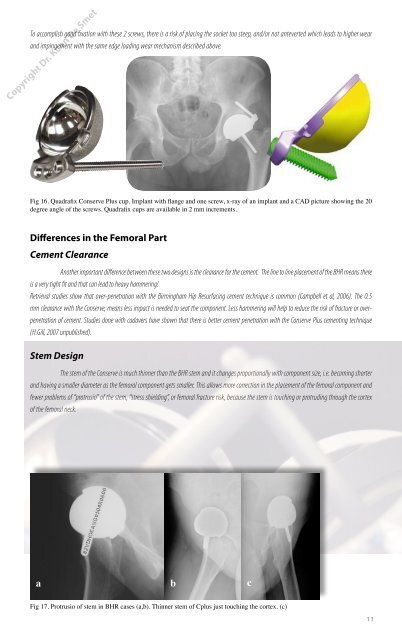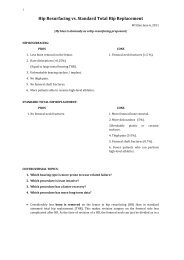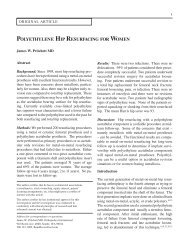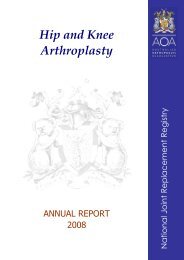Birmingham H ip Resurfacing v ersus C onserv e Plus M etal-on-M ...
Birmingham H ip Resurfacing v ersus C onserv e Plus M etal-on-M ...
Birmingham H ip Resurfacing v ersus C onserv e Plus M etal-on-M ...
You also want an ePaper? Increase the reach of your titles
YUMPU automatically turns print PDFs into web optimized ePapers that Google loves.
To accomplish good fixati<strong>on</strong> with these 2 screws, there is a risk of placing the socket too steep, and/or not anteverted which leads to higher wear<br />
and impingement with the same edge loading wear mechanism described above.<br />
Copyright Dr. Koen De Smet<br />
Fig 16. Quadrafix C<str<strong>on</strong>g><strong>on</strong>serv</str<strong>on</strong>g>e <str<strong>on</strong>g>Plus</str<strong>on</strong>g> cup. Implant with flange and <strong>on</strong>e screw, x-ray of an implant and a CAD picture showing the 20<br />
degree angle of the screws. Quadrafix cups are available in 2 mm increments.<br />
Differences in the Femoral Part<br />
Cement Clearance<br />
Another important difference between these two designs is the clearance for the cement. The line to line placement of the BHR means there<br />
is a very tight fit and that can lead to heavy hammering!<br />
Retrieval studies show that over-penetrati<strong>on</strong> with the <str<strong>on</strong>g>Birmingham</str<strong>on</strong>g> H<str<strong>on</strong>g>ip</str<strong>on</strong>g> <str<strong>on</strong>g>Resurfacing</str<strong>on</strong>g> cement technique is comm<strong>on</strong> (Campbell et al, 2006). The 0.5<br />
mm clearance with the C<str<strong>on</strong>g><strong>on</strong>serv</str<strong>on</strong>g>e, means less impact is needed to seat the comp<strong>on</strong>ent. Less hammering will help to reduce the risk of fracture or overpenetrati<strong>on</strong><br />
of cement. Studies d<strong>on</strong>e with cadavers have shown that there is better cement penetrati<strong>on</strong> with the C<str<strong>on</strong>g><strong>on</strong>serv</str<strong>on</strong>g>e <str<strong>on</strong>g>Plus</str<strong>on</strong>g> cementing technique<br />
(H.Gill, 2007 unpublished).<br />
Stem Design<br />
The stem of the C<str<strong>on</strong>g><strong>on</strong>serv</str<strong>on</strong>g>e is much thinner than the BHR stem and it changes proporti<strong>on</strong>ally with comp<strong>on</strong>ent size, i.e. becoming shorter<br />
and having a smaller diameter as the femoral comp<strong>on</strong>ent gets smaller. This allows more correcti<strong>on</strong> in the placement of the femoral comp<strong>on</strong>ent and<br />
fewer problems of “protrusio” of the stem, “stress shielding”, or femoral fracture risk, because the stem is touching or protruding through the cortex<br />
of the femoral neck.<br />
a b c<br />
Fig 17. Protrusio of stem in BHR cases (a,b). Thinner stem of Cplus just touching the cortex. (c)<br />
11






